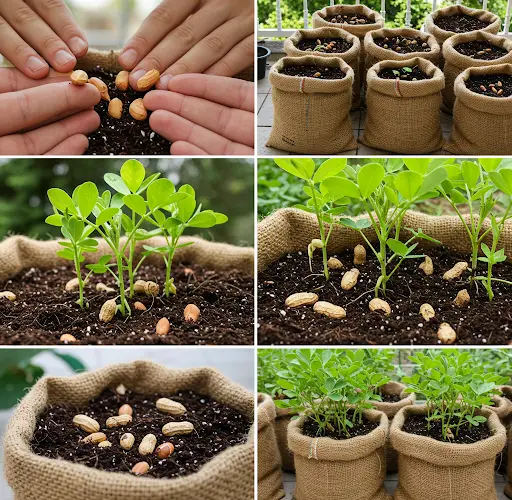How to Grow Peanuts at Home – A Surprisingly Easy Guide for Beginners
Peanuts are often thought of as a crop grown on vast fields, but did you know you can grow them right at home with very little space? Whether in a backyard, balcony, or even a container, growing peanuts is not only easy but also rewarding. With minimal care and the right conditions, beginners can enjoy harvesting fresh, homegrown peanuts from just a few plants.
This guide walks you through everything you need to grow peanuts at home, step by step.
Why Grow Peanuts at Home?
Peanuts (also known as groundnuts) are rich in protein, healthy fats, and essential minerals. When grown at home, they’re free from synthetic chemicals, making them a healthier, fresher option for snacking or cooking.
What makes peanuts especially interesting is how they grow: after the plant flowers, the fertilized flower stalk (called a “peg”) grows downward into the soil, where the peanuts form underground. It’s a fascinating process to watch unfold—and a fun project for families, kids, and home gardeners alike.
What You Need to Get Started
-
Raw, untreated peanuts: You can often find these at garden centers or health food stores. Make sure they’re still in the shell and not roasted.
-
Loose, sandy soil: Peanuts grow best in light, well-draining soil that allows the pegs to penetrate easily.
-
Containers or garden space: If you’re planting in pots, choose ones that are at least 12 inches deep and wide.
-
A warm, sunny location: Peanuts need full sun and at least 90 to 120 frost-free days to mature.
Step-by-Step: Growing Peanuts at Home
1. Sprouting the Seeds (Optional)
To give your peanuts a head start, you can sprout them indoors:
-
Crack open raw peanuts and remove the shells carefully.
-
Place the seeds (still with the papery skin) between damp paper towels.
-
Keep them in a warm, shaded spot for 4–7 days.
-
Once roots emerge, they’re ready to be planted.
You can also sow them directly outdoors if your growing season is long enough.
2. Preparing the Soil or Container
Peanuts need loose, sandy soil to develop underground pods. Whether planting in the ground or a pot, mix in compost or organic matter to enrich the soil. Avoid heavy, clay-rich soils which can hinder peg development.
Ideal pH: 5.8 to 6.5
Ideal temperature: 70–85°F (21–29°C)
In containers, ensure there’s good drainage. Fabric grow bags also work great.
3. Planting the Peanuts
-
Plant seeds 1–2 inches deep, with about 6–8 inches between plants.
-
Space rows at least 18–24 inches apart if planting in a garden bed.
-
Water gently after planting to settle the soil.
In pots, place one to two seeds per container, depending on the size.
4. Caring for Your Peanut Plants
-
Watering: Keep the soil evenly moist but not soggy. Peanuts need consistent watering, especially during flowering and pod formation.
-
Sunlight: Ensure they get at least 6–8 hours of sunlight daily.
-
Mulching: Once plants are a few inches tall, mulch around the base to retain moisture and prevent weeds.
Peanuts don’t need heavy feeding. A light application of compost or organic fertilizer during early growth is sufficient.
5. Flowering and Pegging
After about 30–40 days, the plants will flower. The small yellow flowers appear above ground, and once pollinated, the pegs grow downward into the soil.
At this stage, it’s important to keep the soil loose and weed-free. Avoid disturbing the area where the pegs are burying themselves.
6. Harvesting Peanuts
Peanuts are ready to harvest about 100–120 days after planting, depending on the variety. Signs of maturity include:
-
The foliage starts to yellow.
-
The pods feel full when gently squeezed underground.
-
A few pods can be pulled and checked—mature peanuts will have well-formed shells and kernels.
To harvest:
-
Loosen the soil gently with a hand fork or spade.
-
Pull up the entire plant and shake off the excess soil.
-
Hang the plant upside down in a dry, shaded area for about 1–2 weeks to cure.
Bonus: Growing Tips
-
Rotate crops yearly to avoid soil-borne diseases.
-
Interplant with marigolds or basil to deter pests.
-
Don’t over-fertilize—too much nitrogen can reduce pod production.
Final Thoughts
Growing peanuts at home is both fun and fulfilling. It’s a low-maintenance crop that doesn’t require a lot of space, making it perfect for home gardeners, even those in urban environments. With just a bit of care and attention, you’ll be rewarded with your own fresh batch of peanuts—perfect for roasting, boiling, or using in homemade peanut butter.
Try planting a few this season, and experience the joy of harvesting a truly unique underground treasure from your own home.



